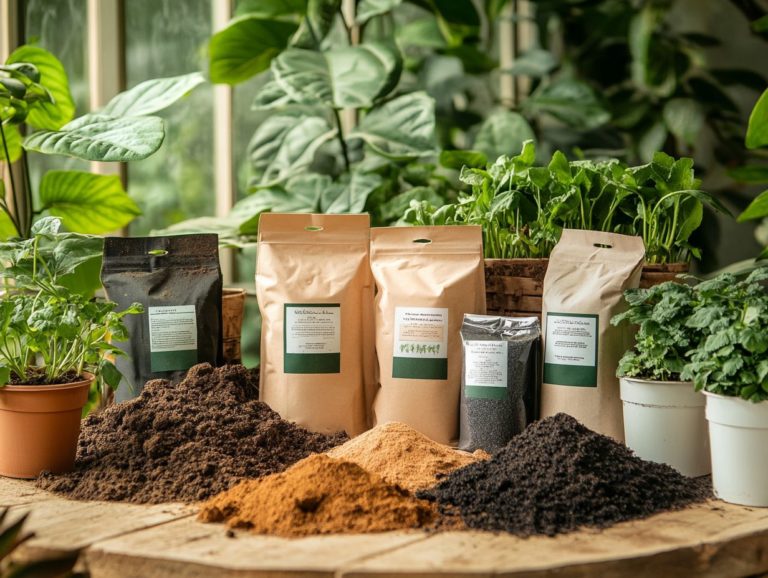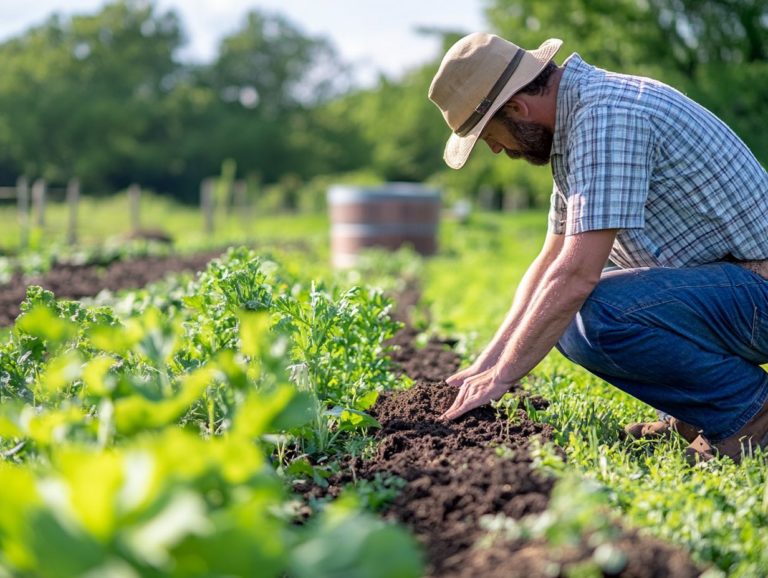How to Implement Crop Rotation Successfully
Crop rotation transcends mere farming technique; it stands as a sustainable practice that can profoundly enhance soil health and elevate your crop yields.
This article delves into the myriad benefits of crop rotation, highlighting its vital role in creating a resilient ecosystem with sustainable practices. You ll discover essential factors to consider when planning your rotation, along with a detailed implementation guide, pitfalls to steer clear of, and the long-term advantages that come from adopting this beneficial method.
Whether you re a seasoned farmer or a passionate gardening enthusiast, this guide equips you with the knowledge necessary to make crop rotation a resounding success.
Contents
- Key Takeaways:
- Benefits of Crop Rotation
- How to Plan for Crop Rotation
- Implementing Crop Rotation
- Common Mistakes to Avoid
- Long-Term Effects of Crop Rotation
- Frequently Asked Questions
- What is crop rotation? Why is it crucial for sustainable farming?
- How do I plan for a successful crop rotation?
- When should I rotate my crops?
- Can I rotate crops in a small garden or container garden?
- What are some common crop rotation mistakes to avoid?
- What are the benefits of implementing crop rotation?
Key Takeaways:

- Plan carefully before implementing crop rotation, considering factors such as soil health, plant nutrient needs, and pest management.
- Rotate crops strategically to improve soil health, increase yield, and reduce pest and disease pressure.
- Avoid common mistakes such as planting the same crops in the same area or not allowing enough time for crop recovery.
What is Crop Rotation?
Crop rotation is an agricultural practice that involves alternating the species of crops you grow on a specific piece of land from year to year. This method enhances soil fertility and promotes ecological balance, allowing you to manage soil health effectively while minimizing challenges posed by pests and crop diseases.
By utilizing various crop families like legumes, maize, beans, and wheat you can improve the process where certain plants improve nitrogen levels in the soil and maintain nutrient cycling, making crop rotation a cornerstone of sustainable agriculture.
Historically, this practice dates back thousands of years, with civilizations recognizing its benefits in maintaining soil vitality and yields. The ancient Romans and Chinese, for example, employed crop rotation to sustain their agricultural systems, showcasing a keen awareness of resource management long before modern agricultural science came into play.
In today s farming landscape, integrating crops like legumes into your rotation schedules not only boosts nitrogen levels in the soil but also disrupts pest life cycles, reducing the need for substances used to kill pests that can harm crops. This strategic practice also contributes to long-term farm productivity and fosters a healthier ecosystem, ultimately benefiting both you as a farmer and consumers alike.
Benefits of Crop Rotation
Crop rotation offers exciting benefits that can transform your farming experience! This sustainable agricultural practice plays a crucial role in boosting soil fertility and improving crop yields while also offering economic advantages for producers like you.
By maintaining a balanced nutrient profile in the soil, you can reduce your reliance on chemical fertilizers and effectively manage pest populations. The result? Healthier crops and increased agricultural yields that contribute to your overall success.
Improving Soil Health and Yield
Improving soil health and yield through crop rotation requires you to engage in thoughtful planning around crop diversity and the integration of organic matter into your soil. By alternating between deep-rooted and shallow-rooted crops, you can enhance soil structure, reduce compaction, and promote a balanced nutrient profile rich in nitrogen essential for maximizing your crop yield.
Incorporating organic matter, like compost or cover crops, plays a vital role in building a thriving ecosystem within the soil, creating an environment that nurtures beneficial microorganisms. These practices not only boost soil fertility but also enhance water retention and aeration, both critical for the overall health of your plants. Embracing crop diversity allows for natural pest control, reducing your reliance on chemical inputs and promoting sustainable farming practices.
Deep-rooted plants can tap into nutrients and moisture from deeper soil layers, increasing resilience during dry spells and ultimately leading to a more productive agricultural system. By adopting these strategies, you re not just improving your soil; you re investing in a more sustainable and fruitful future for your crops.
How to Plan for Crop Rotation

Successful crop rotation requires careful planning. Consider factors like crop compatibility, seasonal patterns, and harvest times.
A comprehensive crop schedule maximizes ecological benefits. It also minimizes challenges from growing only one type of crop.
Factors to Consider
When planning your crop rotation, consider various factors to optimize soil fertility, ways to control pests, and water efficiency.
Soil type is crucial, as different textures can influence water retention and nutrient availability. Don t underestimate your local climate s impact. Temperature and rainfall can greatly affect your crop choices.
Using effective pest control methods can elevate your sustainable agriculture practices. Embracing modern technologies like precision farming tools will provide valuable insights into soil health and moisture levels.
Implementing Crop Rotation
Implementing crop rotation means embracing farming techniques that prioritize soil health and crop diversity. This can include practices like no-till farming and integrating different crop families.
Adopt this approach to boost your farming success! It maximizes the benefits of seasonal growth cycles.
Step-by-Step Guide
A step-by-step guide involves evaluating soil health, formulating crop strategies, and using tools for effective field monitoring.
The first step is conducting a thorough soil assessment. A soil assessment reveals vital details like nutrient levels and pH balance. This information helps you choose the best crops.
Once you’ve selected appropriate crops, establish a rotation schedule that accommodates diverse growth cycles. This helps ward off pest infestations and prevents nutrient depletion.
Regularly monitor your fields using the right tools to gain insights into crop performance and soil conditions. This will help you make necessary adjustments for optimal results.
Common Mistakes to Avoid

Avoiding common mistakes is crucial for soil health. Problems like growing only one type of crop can lead to pest issues and crop diseases.
- Neglecting soil assessments
- Ignoring local climate impacts
- Overlooking crop diversity
By grasping these pitfalls, you can implement effective pest management strategies that protect your crops and enhance your farming practices.
Tips for a Successful Rotation
To achieve a successful crop rotation, it’s essential for you to develop effective crop strategies that optimize water efficiency and management practices. By utilizing diverse crop families and understanding their unique requirements, you can enhance soil health and yield. For more insights on this, check out how to implement crop rotation in permaculture to ensure sustainable agricultural production.
Incorporating legumes into your rotation naturally fixes nitrogen in the soil. This reduces the need for chemical fertilizers. Rotating deep-rooted plants with shallow-rooted varieties can significantly improve nutrient absorption and soil structure while minimizing compaction. Implementing cover crops during the off-seasons not only protects the soil from erosion but also enhances moisture retention.
Staying informed about local climate conditions and selecting drought-resistant varieties can further bolster your water conservation efforts. These strategic practices foster biodiversity, which refers to the variety of different plants, animals, and microorganisms in an ecosystem. This leads to robust ecosystems that are more resilient against pests and diseases, ultimately benefiting your entire farming operation.
Long-Term Effects of Crop Rotation
The long-term benefits of crop rotation can greatly elevate environmental sustainability and enhance soil health, ultimately resulting in improved agricultural yields for you. This proven practice can boost your crop yields! It maintains nutrient balance and fosters the growth of beneficial microorganisms in the soil.
As a result, you cultivate more resilient and productive farming systems that stand the test of time.
Sustainable Farming Practices in Modern Agriculture
Sustainable farming practices, like crop rotation, are essential for enhancing soil health, promoting nutrient cycling, and reaping numerous ecological benefits. By incorporating these practices into your farming systems, you can cultivate a more resilient agricultural ecosystem that balances productivity with environmental sustainability.
Implementing crop rotation enables you to diversify your crops, which helps reduce your dependence on chemical fertilizers and pesticides that can harm the soil over time. This natural approach fosters beneficial microorganisms and improves soil structure, resulting in better water retention and increased organic matter content.
Since different crops have unique nutrient needs and root structures, rotating them not only replenishes vital nutrients but also disrupts pest and disease cycles, leading to healthier yields. Utilizing nitrogen-rich soil by planting legumes further enhances crop diversity. Ultimately, embracing these sustainable methods enhances your farm’s viability and protects the environment for generations to come.
Frequently Asked Questions

What is crop rotation? Why is it crucial for sustainable farming?
Crop rotation is the practice of growing different crops in the same area over a period of time. It is important because it helps to maintain soil health, reduce pest and disease pressure, and improve overall crop yield.
How do I plan for a successful crop rotation?
To plan for a successful crop rotation, evaluate your current crops, consider the nutrient needs of each crop, and determine the best crop sequence for your specific climate and soil conditions. Take into account seasonal patterns and planting techniques.
When should I rotate my crops?
The timing of crop rotation depends on your specific growing season and the types of crops you are planting, including perennial plants and deep-rooted plants. In general, it is recommended to rotate crops every 2-3 years to maximize the benefits and avoid potential negative impacts.
Can I rotate crops in a small garden or container garden?
Yes, crop rotation can be implemented in small gardens or even container gardens. Plan for crop rotation by using different types of containers or moving plants to different areas in your garden each season, ensuring a balance of crop cycles.
What are some common crop rotation mistakes to avoid?
Avoid planting the same crop family in the same spot each year. Failing to consider the nutrient needs of each crop can harm your soil.
Plan for cover crops to improve soil health. This helps prevent issues like soil compaction.
What are the benefits of implementing crop rotation?
Crop rotation boosts soil health and crop yield. It also significantly reduces weed growth and promotes biodiversity.
These practices enhance overall farm sustainability. This can lead to significant financial gains.
Crop rotation means alternating the types of crops you grow in a specific area to maintain soil health and improve yields. Start planning your crop rotation today for a healthier and more productive garden!






